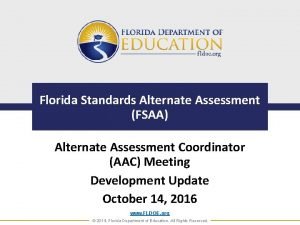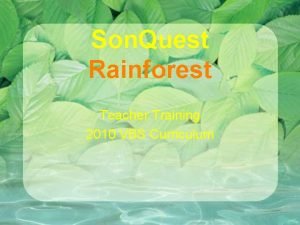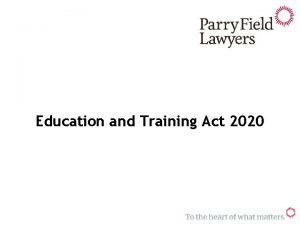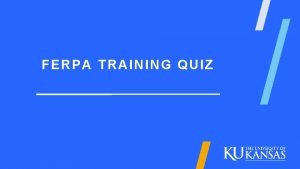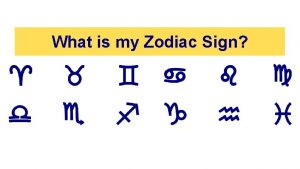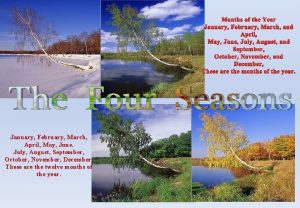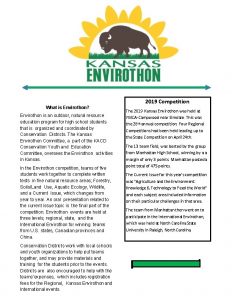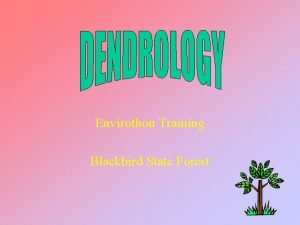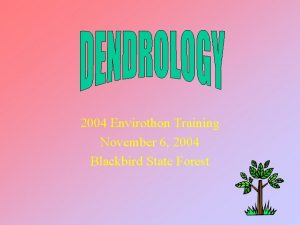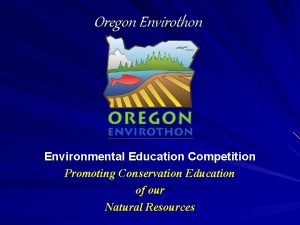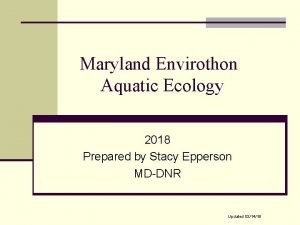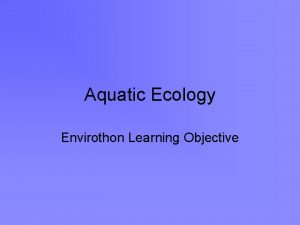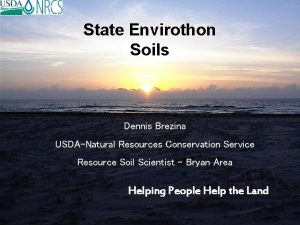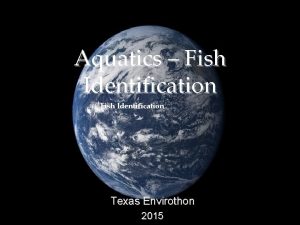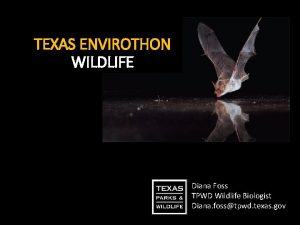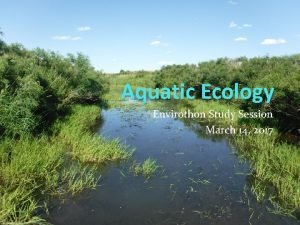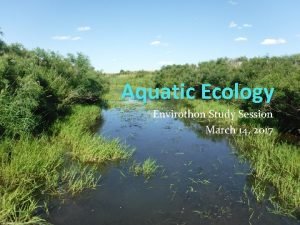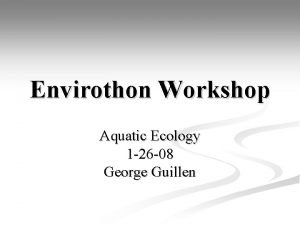Envirothon Teacher Training January 15 2020 11 50

























- Slides: 25

Envirothon Teacher Training January 15, 2020 11: 50 -12: 50 pm Grand Island, NE Monica Macoubrie Monica. macoubrie@nebraska. gov Wildlife Education Specialist/NE Project WILD State Coordinator Nebraska Game and Parks Commission

Mammal Skull, Pelt, & Track Identification

Bobcat (Lynx rufus) • Skull – Short and squat (4 -7 inches long) – Binocular vision – Large canines – Small quantity of teeth (carnivore) • Pelt – Tail – Spots on ventral side • Track – – – Front of heel pad 2 lobes Back of heel pad 3 lobes No claw marks 1 ½ inch long- front 1 3/8 inch wide- front

Raccoon (Procyon lotor) • Skull – Non-descript – Very similar to badgerthough not triangular – Different types of teeth – ~4. 5 inches long • Pelt – Ringed tail – Salt and Pepper coloring – Dark spots around eyes • Track – 5 slender toes – Feet resemble small human hands – Claws sometimes visible

• Skull Opossum (Didelphis virginiana) – Weird! – Large sagittal crest – Large quantity of teeth – Overbite with canines – ~4. 3 inches long • Pelt – Mostly grayish color – Long naked tail – Small ears • Track – 5 toes – Front footprint is wider than it is long – 1. 5 inches long – 2 inches wide

Coyote (Canis latrans) • Skull – – • Similar to fox but larger Large canines Binocular vision ~7. 5 inches Pelt – Depends on season when taken (reddish-orange) (Salt and pepper gray) – Large ears – Long legs • Track – Similar to fox but larger – 2. 5 inch long x 2. 35 inches wide – Claws usually present – One lobe on pad

• Skull – – – • Mountain Lion (Puma concolor) Large skull! Large canines Small quantity of teeth Binocular vision Squat/wide skull Pelt – Light brown to dark brown – Tail length = body length – Large paws • Track – Very large! (diameter of baseball) – Top part of pad has 2 lobes, back has 3 – ~3. 5 inches long x 3. 5 inches wide

White-tailed Deer (Odocoileus virginianus) • Skull – – • Elongated nose cavity No canines- molars only Peripheral vision Large skull Pelt – Light brown color – White tail – Large pelt • Track – – Heart shaped Concave wall Distinctive 2 parts 3. 0 inches long x 1. 9 inches wide

Ecoregions of Nebraska

Tallgrass Prairie • • • Tallgrass Prairie • • • Most endangered ecosystem in the world 25 -36 inches of rain annually Big Blue Stem, Indian Grass, Switchgrass Wildflowers, forbs Native Woodlands- bluffs, Wet meadows 300 species of birds 55 mammal species 75 fish 53 amphibians & Reptiles Insects!! **Southern Flying Squirrel, Timber Rattlesnake, Massasauga, Regal Fritallary, Pallid Sturgeon, Piping Plover, Bell’s Vireo, Saltwort

Mixedgrass Prairie • • • Mixed grass Prairie • • • Transition Zone 20 -28 inches of rain annually Ogallala Aquifer Rainwater Basin- wetlands & migratory birds Tallgrass plants in east, shortgrass plants in west 350 migratory birds Many mammals- elk, Ord’s Kangaroo Rat Reptiles & Amphibians **Holds largest populations of American Burying Beetles Burrowing Owl, Prairie Chicken, Whooping Crane Platte River Blanding’s Turtle

Sandhills • • • Sandhills • • • Largest stabilized dune system in the Western Hempisphere 17 -23 inches of rain annually 1, 000 acres of wetlands 700 native plant species Blowout Penstemon 300 species of migratory birds 55 species of mammals Bailey’s Eastern Woodrat 75 species of fish 27 reptiles & amphibians **Trumpeter Swan, Burying Beetle, Finescale Dace, Small White Lady’sslipper, Western Prairie Fringed Orchid, Blanding’s Turtle

Shortgrass Prairie • • Shortgrass Prairie • • • Diverse topography 12 -17 inches of rain annually Buffalo grass and Blue Grama, Plants rarely exceed 10 inches in height Pine woodlands. Ponderosa Pine Ungulate mammals dominate- Bighorn Sheep, Mule Deer, Pronghorn, Elk Prairie Dogs, Mountain Lions, Swift Fox, Lots of fish species- small stream fish like Dace Prairie Rattlesnake, Mountain Short Horned Lizard, Ornate Box Turtle **Colorado Butterfly Plant, Swift Fox, Ferruginous Hawk, Mountain Plover,

Threatened & Endangered Species

State Threatened & Endangered • State Threatened- 14 species • **Piping Plover, Southern Flying Squirrel, Western Massasauga • State Endangered- 17 species • **Whooping Crane, Swift Fox, Pallid Sturgeon, American Burying Beetle Blowout Penstemon http: //outdoornebraska. gov/wpcontent/uploads/formidable/State. Species-List_02152017. pdf

Federally Threatened & Endangered • Federally Threatened- 6 species • **Colorado Butterfly Plant • Federally Endangered- 11 species • **Scaleshell mussel, Whooping Crane • A complete list can be found at: http: //rarespecies. nebraska. gov/

Listing Action Considerations • Mc. Cown’s Longspur- proposed to be added to Threatened Species List • Timber Rattlesnake- proposed to be added to Threatened Species List • North American River Otter- proposed for delisting • Flathead Chub, Plains Minnow, Sicklefin Chub, Western Silvery Minnow- proposed to be added to Threatened Species List

Know these! • • • Limiting Factor Extirpated Endemic Native Non-native Introduced Carrying Capacity Succession Invasive Carnivore Herbivore Fossorial Phototrophic Crepuscular Monotypic Insectivore Omnivore Piscivore Ungulate Density Dependent Factors • Zoonotic • • •

Family Names • • • Pronghorn- Antilocapridae Rabbits- Leporidae Mustelidae Felidae Canidae Didelphidae- opossum

Taxonomic Hierarchy

Basic Anatomy

• • • Basic Biological Information Beaver Bobcat Coyote Mountain Lion Opossum Raccoon Prairie Dogs Whooping Cranes Elk Turkey Bighorn Sheep Prairie Chicken

Nebraska “Hot” Topics

• • • Pollinators White-nose syndrome Epizootic Hemorrhagic Disease (EHD) Climate Change Mountain Lions Invasive Species Prescribed Fire Threatened & Endangered Species Monarchs Wildlife Diseases Legislation- RAWA (The Recovering America’s Wildlife Act will redirect $1. 3 billion of existing revenue annually to state-led wildlife conservation efforts, effectively allowing the states to more fully implement their State Wildlife Action Plans)

Questions?
 Erf meaning
Erf meaning Good afternoon my dear students
Good afternoon my dear students Teacher goals for 2020-2021
Teacher goals for 2020-2021 Viikki teacher training school
Viikki teacher training school Nature of assessment for learning
Nature of assessment for learning Fsaa practice test
Fsaa practice test Montessori early learning foundation
Montessori early learning foundation Igcse teacher training
Igcse teacher training Carter review of initial teacher training
Carter review of initial teacher training Designated teacher training
Designated teacher training Vbs teacher training
Vbs teacher training Viikki teacher training school
Viikki teacher training school Igcse teacher training
Igcse teacher training Cie past papers chemistry
Cie past papers chemistry Russell stannard teacher training videos
Russell stannard teacher training videos Education and training act 2020 summary
Education and training act 2020 summary Pd
Pd Safe schools ferpa training answers
Safe schools ferpa training answers Telpas online training
Telpas online training Telpas calibration answers
Telpas calibration answers Mozart who was born on january
Mozart who was born on january Zodiac for january 20
Zodiac for january 20 4 january 1643
4 january 1643 February and march season
February and march season January february march
January february march June 2018 chemistry regents
June 2018 chemistry regents





